Microbial Inoculation Improves Growth, Nutritional and Physiological Aspects of Glycine max (L.) Merr.
Abstract
:1. Introduction
2. Materials and Methods
2.1. Microbial Isolates and Inoculum Preparation
2.2. Soil Treatment, Seed Biopriming, and Planting
2.3. Promotion of Growth and Nutrient Content
2.4. Gas Exchange and Chlorophyll Index
2.5. Chlorophyll a Fluorescence
2.6. Experimental Design and Statistical Analyses
3. Results
3.1. Promotion of Plant Growth and Nutrient Contents
3.2. Gas Exchange and Chlorophyll Index
3.3. Chlorophyll a Fluorescence
3.4. Correlation Matrix between Variables and PCA
4. Discussion
4.1. Microbial Inoculation Had a Positive Effect on the Growth of G. max, Especially with Strains PA12 (P. alvei), SC5 (B. cereus), and SC15 (P. sheari)
4.2. Non-Inoculated Plants Had Lower Nutrient Contents in the Aerial Part and Whole Plant, Reduced Chlorophyll Index, and Low Photosynthetic Rate and Photochemical Efficiency Compared to the Inoculated Plants
4.3. The Strains PA12 (P. alvei), SC5 (B. cereus), and 328EF (Codinaeopsis sp.) Stood Out in Optimizing Nutrient Concentration, Transpiration Rate, and Stomatal Conductance in G. max
5. Conclusions
Author Contributions
Funding
Data Availability Statement
Acknowledgments
Conflicts of Interest
References
- Gawęda, D.; Nowak, A.; Haliniarz, M.; Woźniak, A. Yield and economic effectiveness of soybean grown under different cropping systems. Int. J. Plant Prod. 2020, 14, 475–485. [Google Scholar] [CrossRef] [Green Version]
- Meng, X.; Chen, W.W.; Wang, Y.Y.; Huang, Z.R.; Ye, X.; Chen, L.S.; Yang, L.T. Effects of phosphorus deficiency on the absorption of mineral nutrients, photosynthetic system performance and antioxidant metabolism in Citrus grandis. PLoS ONE 2021, 16, e0246944. [Google Scholar] [CrossRef] [PubMed]
- Henry, J.B.; Perkins-Veazie, P.; McCall, I.; Whipker, B.E. Restricted phosphorus fertilization increases the betacyanin concentration and red foliage coloration of alternanthera. J. Am. Soc. Hortic. Sci. 2019, 144, 264–273. [Google Scholar] [CrossRef] [Green Version]
- Reddy, V.R.; Cunha, D.G.F.; Kurian, M. A water-energy-food nexus perspective on the challenge of eutrophication. Water 2018, 10, 101. [Google Scholar] [CrossRef] [Green Version]
- Edwards, C.L.; Maguire, R.O.; Alley, M.M.; Thomason, W.E.; Whitehurst, G.B. Plant-available phosphorus after application of synthetic chelating agents. Commun. Soil Sci. Plant Anal. 2016, 47, 433–446. [Google Scholar] [CrossRef]
- Chen, R.; Song, S.; Li, X.; Liu, H.; Huang, D. Phosphorus deficiency restricts plant growth but induces pigment formation in the flower stalk of Chinese kale. Hortic. Environ. Biotechnol. 2013, 54, 243–248. [Google Scholar] [CrossRef]
- Zhu, J.; Li, M.; Whelan, M. Phosphorus activators contribute to legacy phosphorus availability in agricultural soils: A review. Sci. Total Environ. 2018, 612, 522–537. [Google Scholar] [CrossRef] [Green Version]
- Bargaz, A.; Elhaissoufi, W.; Khourchi, S.; Benmrid, B.; Borden, K.A.; Rchiad, Z. Benefits of phosphate solubilizing bacteria on belowground crop performance for improved crop acquisition of phosphorus. Microbiol. Res. 2021, 252, 126842. [Google Scholar] [CrossRef]
- Estrada-Bonilla, G.A.; Durrer, A.; Cardoso, E.J. Use of compost and phosphate-solubilizing bacteria affect sugarcane mineral nutrition, phosphorus availability, and the soil bacterial community. Appl. Soil Ecol. 2021, 157, 103760. [Google Scholar] [CrossRef]
- Lucero, C.T.; Lorda, G.S.; Anzuay, M.S.; Ludueña, L.M.; Taurian, T. Peanut endophytic phosphate solubilizing bacteria increase growth and P content of soybean and maize plants. Curr. Microbiol. 2021, 78, 1961–1972. [Google Scholar] [CrossRef]
- Rawat, P.; Das, S.; Shankhdhar, D.; Shankhdhar, S.C. Phosphate-solubilizing microorganisms: Mechanism and their role in phosphate solubilization and uptake. J. Soil Sci. Plant Nutr. 2021, 21, 49–68. [Google Scholar] [CrossRef]
- Riaz, U.; Murtaza, G.; Anum, W.; Samreen, T.; Sarfraz, M.; Nazir, M.Z. Plant Growth-Promoting Rhizobacteria (PGPR) as biofertilizers and biopesticides. In Microbiota and Biofertilizers; Springer: Cham, Switzerland, 2021; pp. 181–196. [Google Scholar] [CrossRef]
- Nor, M.N.M. Isolation and Characterization of Effective Microorganism from Oil Palm Rhizhopheric Soil and Evaluation of Their Potential as Biofertiliser. In IOP Conference Series: Earth and Environmental Science; IOP Publishing: Bristol, UK, 2020; Volume 515, p. 012040. [Google Scholar] [CrossRef]
- Alori, E.T.; Glick, B.R.; Babalola, O.O. Microbial phosphorus solubilization and its potential for use in sustainable agriculture. Front. Microbiol. 2017, 8, 971. [Google Scholar] [CrossRef] [PubMed] [Green Version]
- Abhilash, P.C.; Dubey, R.K.; Tripathi, V.; Gupta, V.K.; Singh, H.B. Plant growth-promoting microorganisms for environmental sustainability. Trends Biotechnol. 2016, 34, 847–850. [Google Scholar] [CrossRef] [PubMed]
- Compant, S.; Samad, A.; Faist, H.; Sessitsch, A. A review on the plant microbiome: Ecology, functions, and emerging trends in microbial application. J. Adv. Res. 2019, 19, 29–37. [Google Scholar] [CrossRef] [PubMed]
- Ma, M.; Jiang, X.; Wang, Q.; Guan, D.; Li, L.; Ongena, M.; Li, J. Isolation and identification of PGPR strain and its effect on soybean growth and soil bacterial community composition. Int. J. Agric. Biol. 2018, 20, 1289–1297. [Google Scholar] [CrossRef]
- Blanco, M. Supply of and Access to Key Nutrients NPK for Fertilizers for Feeding the World in 2050; UPM: Madrit, Spain, 2011. [Google Scholar]
- Kazakova, I. Characteristic features of the formation of the global and domestic markets of mineral fertilizers. Econ. Forecast 2015, 2, 104–118. [Google Scholar] [CrossRef] [Green Version]
- Cordell, D.; White, S. Peak phosphorus: Clarifying the key issues of a vigorous debate about long-term phosphorus security. Sustainability 2011, 3, 2027–2049. [Google Scholar] [CrossRef] [Green Version]
- Miransari, M. Soil microbes and plant fertilization. Appl. Microbiol. Biotechnol. 2011, 92, 875–885. [Google Scholar] [CrossRef]
- Hakim, S.; Naqqash, T.; Nawaz, M.S.; Laraib, I.; Siddique, M.J.; Zia, R.; Mirza, M.S.; Imran, A. Rhizosphere engineering with plant growth-promoting microorganisms for agriculture and ecological sustainability. Front. Sustain. Food Syst. 2021, 5, 16. [Google Scholar] [CrossRef]
- Reis, M.N.O.; Bessa, L.A.; de Jesus, A.P.; Silva, F.G.; Moreira, M.A.; Vitorino, L.C. Efficiency of the Hydroponic System as an Approach to Confirm the Solubilization of CaHPO4 by Microbial Strains Using Glycine max as a Model. Front. Plant Sci. 2021, 12, 759463. [Google Scholar] [CrossRef]
- Köhl, J.; Kolnaar, R.; Ravensberg, W.J. Mode of action of microbial biological control agents against plant diseases: Relevance beyond efficacy. Front. Plant Sci. 2019, 10, 845. [Google Scholar] [CrossRef] [PubMed] [Green Version]
- Haney, C.H.; Samuel, B.S.; Bush, J.; Ausubel, F.M. Associations with rhizosphere bacteria can confer an adaptive advantage to plants. Nat. Plants 2015, 1, 15051. [Google Scholar] [CrossRef] [PubMed] [Green Version]
- Pii, Y.; Mimmo, T.; Tomasi, N.; Terzano, R.; Cesco, S.; Crecchio, C. Microbial interactions in the rhizosphere: Beneficial influences of plant growth-promoting rhizobacteria on nutrient acquisition process. A review. Biol. Fertil. Soils 2015, 51, 403–415. [Google Scholar] [CrossRef]
- Mohite, B. Isolation and characterization of indole acetic acid (IAA) producing bacteria from rhizospheric soil and its effect on plant growth. J. Soil Sci. Plant Nutr. 2013, 13, 638–649. [Google Scholar] [CrossRef]
- Sharma, S.B.; Sayyed, R.Z.; Trivedi, M.H.; Gobi, T.A. Phosphate solubilizing microbes: Sustainable approach for managing phosphorus deficiency in agricultural soils. SpringerPlus 2013, 2, 587. [Google Scholar] [CrossRef] [Green Version]
- Billah, M.; Khan, M.; Bano, A.; Hassan, T.U.; Munir, A.; Gurmani, A.R. Phosphorus and phosphate solubilizing bacteria: Keys for sustainable agriculture. Geomicrobiol. J. 2019, 36, 904–916. [Google Scholar] [CrossRef]
- Wu, F.; Li, J.; Chen, Y.; Zhang, L.; Zhang, Y.; Wang, S.; Shi, X.; Li, L.; Liang, J. Effects of phosphate solubilizing bacteria on the growth, photosynthesis, and nutrient uptake of Camellia oleifera abel. Forests 2019, 10, 348. [Google Scholar] [CrossRef] [Green Version]
- Rafi, M.M.; Krishnaveni, M.S.; Charyulu, P.B.B.N. Phosphate-solubilizing microorganisms and their emerging role in sustainable agriculture. In Recent Developments in Applied Microbiology and Biochemistry; Academic Press: Dordrecht, The Netherlands, 2019; pp. 223–233. [Google Scholar] [CrossRef]
- Liu, X.; Li, Q.; Li, Y.; Guan, G.; Chen, S. Paenibacillus strains with nitrogen fixation and multiple beneficial properties for promoting plant growth. PeerJ. 2019, 7, e7445. [Google Scholar] [CrossRef] [Green Version]
- Dash, N.; Pahari, A.; Dangar, T.K. Functionalities of phosphate-solubilizing bacteria of rice rhizosphere: Techniques and perspectives. In Recent Advances in Applied Microbiology; Springer: Singapore, 2017; pp. 151–163. [Google Scholar] [CrossRef]
- de Souza Rocha, A.F.; Vitorino, L.C.; Bessa, L.A.; Costa, R.R.G.F.; da Silva Brasil, M.; Souchie, E.L. Soil parameters affect the functional diversity of the symbiotic microbiota of Hymenaea courbaril L., a Neotropical fruit tree. Rhizosphere 2020, 16, 100237. [Google Scholar] [CrossRef]
- da Silva, C.F.; Vitorino, L.C.; Soares, M.A.; Souchie, E.L. Multifunctional potential of endophytic and rhizospheric microbial isolates associated with Butia purpurascens roots for promoting plant growth. Antonie Van Leeuwenhoek 2018, 111, 2157–2174. [Google Scholar] [CrossRef]
- Hoagland, D.R.; Arnon, D.I. The Water-Culture Method for Growing Plants Without Soil; California Agriculture Experiment Station Circular 347-2; University of California College of Agriculture: Berkeley, CA, USA, 1950. [Google Scholar]
- Malavolta, E.; Vitti, G.C.; Oliveira, S.A. Evaluation of the Nutritional Status of Plants: Principles and Applications, 2nd ed.; Potafos: Piracicaba, Brazil, 1997; p. 319. [Google Scholar]
- de Oliveira, S.R.; Raposo, J.L., Jr.; Neto, J.A.G. Fast sequential multi-element determination of Ca, Mg, K, Cu, Fe, Mn and Zn for foliar diagnosis using high-resolution continuum source flame atomic absorption spectrometry: Feasibility of secondary lines, side pixel registration and least-squares background correction. Spectrochim. Acta B At. Spectrosc. 2009, 64, 593–596. [Google Scholar] [CrossRef]
- Oliveira, T.C. Otimização Multivariada e Validação de Métodos Para A Determinação de Boro, Enxofre, Fósforo e Molibdênio em Fertilizante Mineral por ICP OES. 2016. Available online: https://www.lume.ufrgs.br/handle/10183/142151 (accessed on 27 July 2021).
- Guebel, D.V.; Nudel, B.C.; Giulietti, A.M. A simple and rapid micro-Kjeldahl method for total nitrogen analysis. Biotechnol. Tech. 1991, 5, 427–430. [Google Scholar] [CrossRef]
- Strasser, R.J.; Srivastava, A.; Tsimilli-Michael, M. The fluorescence transient as a tool to characterize and screen photosynthetic samples. In Probing Photosynthesis: Mechanisms, Regulation and Adaptation; CRC Press: Boca Raton, FL, USA, 2000; pp. 445–483. [Google Scholar]
- R Core Team. R: A Language and Environment for Statistical Computing; R Foundation for Statistical Computing: Vienna, Austria, 2022; Available online: https://www.R-project.org/ (accessed on 27 March 2022).
- Yadav, A.N.; Verma, P.; Singh, B.; Chauhan, V.S.; Suman, A.; Saxena, A.K. Plant growth promoting bacteria: Biodiversity and multifunctional attributes for sustainable agriculture. Adv. Biotechnol. Microbiol. 2017, 5, 555671. [Google Scholar] [CrossRef]
- Kalaiselvi, P.; Jayashree, R.; Poornima, R. Plant growth promoting Bacillus spp. and Paenibacillus alvei on the growth of Sesuvium portulacastrum for phytoremediation of salt affected soils. Int. J. Curr. Microbiol. Appl. Sci 2019, 8, 2847–2858. [Google Scholar] [CrossRef]
- Kumar, P.; Khare, S.; Dubey, R.C. Diversity of bacilli from disease suppressive soil and their role in plant growth promotion and yield enhancement. N. Y. Sci. J. 2012, 5, 90–111. [Google Scholar]
- Schoina, C.; Stringlis, I.A.; Pantelides, I.S.; Tjamos, S.E.; Paplomatas, E.J. Evaluation of application methods and biocontrol efficacy of Paenibacillus alvei strain K-165, against the cotton black root rot pathogen Thielaviopsis basicola. Biol. Control 2011, 58, 68–73. [Google Scholar] [CrossRef]
- Khan, M.A.; Asaf, S.; Khan, A.L.; Jan, R.; Kang, S.M.; Kim, K.M.; Lee, I.J. Thermotolerance effect of plant growth-promoting Bacillus cereus SA1 on soybean during heat stress. BMC Microbiol. 2020, 20, 175. [Google Scholar] [CrossRef]
- Ding, H.; Niu, B.; Fan, H.; Li, Y.; Wang, Q. Draft genome sequence of Bacillus cereus 905, a plant growth-promoting rhizobacterium of wheat. Genome Announc. 2016, 4, e00489-16. [Google Scholar] [CrossRef] [Green Version]
- Ku, Y.; Xu, G.; Tian, X.; Xie, H.; Yang, X.; Cao, C. Root colonization and growth promotion of soybean, wheat and Chinese cabbage by Bacillus cereus YL6. PLoS ONE 2018, 13, e0200181. [Google Scholar] [CrossRef] [Green Version]
- Baliyan, N.; Dhiman, S.; Dheeman, S.; Kumar, S.; Arora, N.K.; Maheshwari, D.K. Optimization of gibberellic acid production in endophytic Bacillus cereus using response surface methodology and its use as plant growth regulator in chickpea. J. Plant Growth Regul. 2021, 1–11. [Google Scholar] [CrossRef]
- Zeng, Q.; Xie, J.; Li, Y.; Gao, T.; Xu, C.; Wang, Q. Comparative genomic and functional analyses of four sequenced Bacillus cereus genomes reveal conservation of genes relevant to plant-growth-promoting traits. Sci. Rep. 2018, 8, 17009. [Google Scholar] [CrossRef] [PubMed]
- Dwivedi, S.K.; Sangeeta. Role of antagonistic microbes in management of phytopathogenic fungi of some important crops. In Microbial Diversity and Biotechnology in Food Security; Springer: New Delhi, India, 2014; pp. 273–292. [Google Scholar] [CrossRef]
- Kour, D.; Rana, K.L.; Yadav, A.N.; Yadav, N.; Kumar, M.; Kumar, V.; Vyas, P.; Dhaliwal, H.S.; Saxena, A.K. Microbial biofertilizers: Bioresources and eco-friendly technologies for agricultural and environmental sustainability. Biocatal. Agric. Biotechnol. 2020, 23, 101487. [Google Scholar] [CrossRef]
- Miransari, M. Soil microbes and the availability of soil nutrients. Acta Physiol. Plant. 2013, 35, 3075–3084. [Google Scholar] [CrossRef]
- Hajjam, Y.; Cherkaoui, S. The influence of phosphate solubilizing microorganisms on symbiotic nitrogen fixation: Perspectives for sustainable agriculture. J. Mater. 2017, 8, 801–808. [Google Scholar]
- Li, Y.; Li, Q.; Guan, G.; Chen, S. Phosphate solubilizing bacteria stimulate wheat rhizosphere and endosphere biological nitrogen fixation by improving phosphorus content. PeerJ 2020, 8, e9062. [Google Scholar] [CrossRef]
- Coonan, E.C.; Kirkby, C.A.; Kirkegaard, J.A.; Amidy, M.R.; Strong, C.L.; Richardson, A.E. Microorganisms and nutrient stoichiometry as mediators of soil organic matter dynamics. Nutr. Cycl. Agroecosyst. 2020, 117, 273–298. [Google Scholar] [CrossRef]
- Costa, O.Y.; Raaijmakers, J.M.; Kuramae, E.E. Microbial extracellular polymeric substances: Ecological function and impact on soil aggregation. Front. Microbiol. 2018, 9, 1636. [Google Scholar] [CrossRef] [Green Version]
- Pathan, S.I.; Ceccherini, M.T.; Sunseri, F.; Lupini, A. Rhizosphere as hotspot for plant-soil-microbe interaction. In Carbon and Nitrogen Cycling in Soil; Springer: Singapore, 2020; pp. 17–43. [Google Scholar] [CrossRef]
- Ali, S.; Xie, L. Plant growth promoting and stress mitigating abilities of soil born microorganisms. Recent Pat. Food Nutr. Agric. 2020, 11, 96–104. [Google Scholar] [CrossRef]
- Pirog, T.P.; Iutynska, G.O.; Leonova, N.O.; Beregova, K.A.; Shevchuk, T.A. Microbial synthesis of phytohormones. Biotechnol. Acta 2018, 11, 5–24. [Google Scholar] [CrossRef]
- Bolívar-Anillo, H.J.; Garrido, C.; Collado, I.G. Endophytic microorganisms for biocontrol of the phytopathogenic fungus Botrytis cinerea. Phytochem. Rev. 2020, 19, 721–740. [Google Scholar] [CrossRef]
- Pigoleva, S.V.; Zakharchenko, N.S.; Furs, O.V.; Tarlachkov, S.V.; Funtikova, T.V.; Filonov, A.E.; Aripovskii, A.V.; Dyachenko, O.V.; Buryanov, Y.I.; Shevchuk, T.V. Effects of Associative Microorganisms on Plant Growth and Resistance to Xenobiotics and Phytopathogens. Appl. Biochem. Microbiol. 2020, 56, 473–482. [Google Scholar] [CrossRef]
- Sidorova, T.M.; Asaturova, A.M.; Homyak, A.I. Biologically active metabolites of Bacillus subtilis and their role in the control of phytopathogenic microorganisms. Agric. Biol. 2018, 53, 29–37. [Google Scholar] [CrossRef]
- Santos Júnior, V.D.; Nizoli, É.; Galvan, D.; Gomes, R.J.; Biz, G.; Ressutte, J.B.; Rocha, T.D.S.; Spinosa, W.A. Micronutrient requirements and effects on cellular growth of acetic acid bacteria involved in vinegar production. Food Sci. Technol. 2022, 2, e05121. [Google Scholar] [CrossRef]
- Subramani, S.; Perdreau-Dahl, H.; Morth, J.P. The magnesium transporter A is activated by cardiolipin and is highly sensitive to free magnesium in vitro. Elife 2016, 5, e11407. [Google Scholar] [CrossRef]
- Guo, W.; Nazim, H.; Liang, Z.; Yang, D. Magnesium deficiency in plants: An urgent problem. Crop J. 2016, 4, 83–91. [Google Scholar] [CrossRef] [Green Version]
- Tanoi, K.; Kobayashi, N. Leaf Senescence by Magnesium Deficiency. Plants 2015, 4, 756–772. [Google Scholar] [CrossRef] [Green Version]
- Arigony, A.L.V.; de Oliveira, I.M.; Machado, M.; Bordin, D.L.; Bergter, L.; Prá, D.; Pegas Henriques, J.A. The influence of micronutrients in cell culture: A reflection on viability and genomic stability. BioMed Res. Int. 2013, 2013, 597282. [Google Scholar] [CrossRef] [Green Version]
- Suran, P.; Kulhánek, M.; Balík, J.; Černý, J.; Sedlář, O. Evaluation of Soil S Pools under 23 Years of Maize Monoculture. Agronomy 2021, 11, 2376. [Google Scholar] [CrossRef]
- Ma, Q.; Wen, Y.; Pan, W.; Macdonald, A.; Hill, P.W.; Chadwick, D.R.; Wu, L.; Jones, D.L. Soil carbon, nitrogen, and sulphur status affects the metabolism of organic S but not its uptake by microorganisms. Soil Biol. Biochem. 2020, 149, 107943. [Google Scholar] [CrossRef]
- Fox, A.; Kwapinski, W.; Griffiths, B.S.; Schmalenberger, A. The role of sulfur-and phosphorus-mobilizing bacteria in biochar-induced growth promotion of Lolium perenne. FEMS Microbiol. Ecol. 2014, 90, 78–91. [Google Scholar] [CrossRef] [Green Version]
- Narayan, O.P.; Kumar, P.; Yadav, B.; Dua, M.; Johri, A.K. Sulfur nutrition and its role in plant growth and development. Plant Signal. Behav. 2022, 2030082. [Google Scholar] [CrossRef] [PubMed]
- Udayana, S.K.; Singh, P.; Jaison, M.; Roy, A. Sulphur: A boon in agriculture. Pharma Innov. J. 2021, 10, 912–921. [Google Scholar]
- Jeon, J.S.; Etalo, D.W.; Carreno-Quintero, N.; de Vos, R.C.; Raaijmakers, J.M. Effects of Sulfur Assimilation in Pseudomonas fluorescens SS101 on Growth, Defense, and Metabolome of Different Brassicaceae. Biomolecules 2021, 11, 1704. [Google Scholar] [CrossRef] [PubMed]
- Kulczycki, G. The effect of elemental sulfur fertilization on plant yields and soil properties. Adv. Agron. 2021, 167, 105–181. [Google Scholar] [CrossRef]
- Kopriva, S.; Malagoli, M.; Takahashi, H. Sulfur nutrition: Impacts on plant development, metabolism, and stress responses. J. Exp. Bot. 2019, 70, 4069–4073. [Google Scholar] [CrossRef]
- Lurthy, T.; Pivato, B.; Lemanceau, P.; Mazurier, S. Importance of the Rhizosphere Microbiota in Iron Biofortification of Plants. Front. Plant Sci. 2021, 12, 744445. [Google Scholar] [CrossRef]
- Kobayashi, T.; Nozoye, T.; Nishizawa, N.K. Iron transport and its regulation in plants. Free Radic. Biol. Med. 2019, 133, 11–20. [Google Scholar] [CrossRef]
- Verma, S.K.; Sahu, P.K.; Kumar, K.; Pal, G.; Gond, S.K.; Kharwar, R.N.; White, J.F. Endophyte roles in nutrient acquisition, root system architecture development and oxidative stress tolerance. J. Appl. Microbiol. 2021, 131, 2161–2177. [Google Scholar] [CrossRef]
- Holz, M.; Zarebanadkouki, M.; Carminati, A.; Becker, J.N.; Spohn, M. The effect of root hairs on rhizosphere phosphatase activity. J. Plant Nutr. Soil Sci. 2020, 183, 382–388. [Google Scholar] [CrossRef]
- Holz, M.; Zarebanadkouki, M.; Kuzyakov, Y.; Pausch, J.; Carminati, A. Root hairs increase rhizosphere extension and carbon input to soil. Ann. Bot. 2018, 121, 61–69. [Google Scholar] [CrossRef] [Green Version]
- McRose, D.L.; Seyedsayamdost, M.R.; Morel, F.M. Multiple siderophores: Bug or feature? JBIC J. Biol. Inorg. Chem. 2018, 23, 983–993. [Google Scholar] [CrossRef] [PubMed]
- Goteti, P.K.; Emmanuel, L.D.A.; Desai, S.; Shaik, M.H.A. Prospective zinc solubilising bacteria for enhanced nutrient uptake and growth promotion in maize (Zea mays L.). Int. J. Microbiol. 2013, 2013, 869697. [Google Scholar] [CrossRef] [PubMed] [Green Version]
- Smith, S.E.; Read, D.J. Mycorrhizal Symbiosis; Academic Press: New York, NY, USA, 2010. [Google Scholar]
- Vitorino, L.C.; de Souza Rocha, A.F.; Bessa, L.A.; Lourenço, L.L.; da Costa, A.C.; Silva, F.G. Symbiotic microorganisms affect the resilience of Hymenaea courbaril L., a neotropical fruit tree, to water restriction. Plant Stress 2022, 5, 100092. [Google Scholar] [CrossRef]
- Eshaghi, E.; Nosrati, R.; Owlia, P.; Malboobi, M.A.; Ghaseminejad, P.; Ganjali, M.R. Zinc solubilization characteristics of efficient siderophore-producing soil bacteria. Iran. J. Microbiol. 2019, 11, 419. [Google Scholar] [CrossRef]
- Kumar, A.; Dewangan, S.; Lawate, P.; Bahadur, I.; Prajapati, S. Zinc-solubilizing bacteria: A boon for sustainable agriculture. In Plant Growth Promoting Rhizobacteria for Sustainable Stress Management; Springer: Singapore, 2019; pp. 139–155. [Google Scholar] [CrossRef]
- Hussein, K.A.; Joo, J.H. Zinc ions affect siderophore production by fungi isolated from the Panax ginseng rhizosphere. J. Microbiol. Biotechnol. 2019, 29, 105–113. [Google Scholar] [CrossRef]
- Nandal, V.; Solanki, M. Zn as a vital micronutrient in plants. J. Microbiol. Biotechnol. Food Sci. 2021, 11, 262–271. [Google Scholar] [CrossRef]
- Gondal, A.H.; Zafar, A.; Zainab, D.; Toor, M.D.; Sohail, S.; Ameen, S.; Ijaz, A.B.; Ch, B.I.; Hussain, I.; Haider, S.; et al. A detailed review study of zinc involvement in animal, plant and human nutrition. Indian J. Pure Appl. Biosci. 2021, 9, 262–271. [Google Scholar] [CrossRef]
- Maret, W. The redox biology of redox-inert zinc ions. Free Radic. Biol. Med. 2019, 134, 311–326. [Google Scholar] [CrossRef] [Green Version]
- Yuvaraj, M.; Subramanian, K.S. Significance of Zinc in Plant Nutrition. Biotica Res. Today 2020, 2, 823–825. [Google Scholar]
- Gautam, A.; Dubey, R.S. Metal toxicity in plants: Induction of oxidative stress, antioxidative defense system, metabolic alterations and phytoremediation. In Molecular Physiology of Abiotic Stresses in Plant Productivity; American Scientific Publishers: Valencia, CA, USA, 2018; pp. 256–290. [Google Scholar]
- Broadley, M.; Brown, P.; Cakmak, I.; Rengel, Z.; Zhao, F. Function of nutrients: Micronutrients. In Marschner’s Mineral Nutrition of Higher Plants; Academic Press: Cambridge, MA, USA, 2012; pp. 191–248. [Google Scholar]
- Bangera, M.; Gowda, K.G.; Sagurthi, S.R.; Murthy, M.R.N. Structural and functional insights into phosphomannose isomerase: The role of zinc and catalytic residues. Acta Crystallogr. Sect. D Struct. Biol. 2019, 75, 475–487. [Google Scholar] [CrossRef]
- Hacisalihoglu, G. Zinc (Zn): The last nutrient in the alphabet and shedding light on Zn efficiency for the future of crop production under suboptimal Zn. Plants 2020, 9, 1471. [Google Scholar] [CrossRef] [PubMed]
- Kaur, H.; Garg, N. Zinc toxicity in plants: A review. Planta 2021, 253, 1–28. [Google Scholar] [CrossRef] [PubMed]
- Lotfi, R.; Kalaji, H.M.; Valizadeh, G.R.; Khalilvand Behrozyar, E.; Hemati, A.; Gharavi-Kochebagh, P.; Ghassemi, A. Effects of humic acid on photosynthetic efficiency of rapeseed plants growing under different watering conditions. Photosynthetica 2018, 56, 962–970. [Google Scholar] [CrossRef] [Green Version]
- Kalaji, H.M.; Bąba, W.; Gediga, K.; Goltsev, V.; Samborska, I.A.; Cetner, M.D.; Dimitrova, S.; Piszcz, U.; Bielecki, K.; Karmowska, K.; et al. Chlorophyll fluorescence as a tool for nutrient status identification in rapeseed plants. Photosynth. Res. 2018, 136, 329–343. [Google Scholar] [CrossRef] [Green Version]
- Morales, F.; Pavlovič, A.; Abadía, A.; Abadía, J. Photosynthesis in poor nutrient soils, in compacted soils, and under drought. In The Leaf: A Platform for Performing Photosynthesis; Springer: Cham, Switzerland, 2018; pp. 371–399. [Google Scholar] [CrossRef]
- Kalaji, H.M.; Oukarroum, A.; Alexandrov, V.; Kouzmanova, M.; Brestic, M.; Zivcak, M.; Samborska, I.A.; Cetner, M.D.; Allakhverdiev, S.I.; Goltsev, V. Identification of nutrient deficiency in maize and tomato plants by in vivo chlorophyll a fluorescence measurements. Plant Physiol. Biochem. 2014, 81, 16–25. [Google Scholar] [CrossRef]
- Ohnishi, M.; Furutani, R.; Sohtome, T.; Suzuki, T.; Wada, S.; Tanaka, S.; Ifuku, K.; Ueno, D.; Miyake, C. Photosynthetic parameters show specific responses to essential mineral deficiencies. Antioxidants 2021, 10, 996. [Google Scholar] [CrossRef]
- Bayat, L.; Arab, M.; Aliniaeifard, S.; Seif, M.; Lastochkina, O.; Li, T. Effects of growth under different light spectra on the subsequent high light tolerance in rose plants. AoB Plants 2018, 10, ply052. [Google Scholar] [CrossRef]
- Li, L.; Aro, E.M.; Millar, A.H. Mechanisms of photodamage and protein turnover in photoinhibition. Trends Plant Sci. 2018, 23, 667–676. [Google Scholar] [CrossRef]
- Mathur, S.; Tomar, R.S.; Jajoo, A. Arbuscular Mycorrhizal fungi (AMF) protects photosynthetic apparatus of wheat under drought stress. Photosynth. Res. 2019, 139, 227–238. [Google Scholar] [CrossRef]
- Carstensen, A.; Herdean, A.; Schmidt, S.B.; Sharma, A.; Spetea, C.; Pribil, M.; Husted, S. The impacts of phosphorus deficiency on the photosynthetic electron transport chain. Plant Physiol. 2018, 177, 271–284. [Google Scholar] [CrossRef] [Green Version]
- Sachdev, S.; Ansari, S.A.; Ansari, M.I.; Fujita, M.; Hasanuzzaman, M. Abiotic stress and reactive oxygen species: Generation, signaling, and defense mechanisms. Antioxidants 2021, 10, 277. [Google Scholar] [CrossRef] [PubMed]
- Guidi, L.; Lo Piccolo, E.; Landi, M. Chlorophyll fluorescence, photoinhibition and abiotic stress: Does it make any difference the fact to be a C3 or C4 species? Front. Plant Sci. 2019, 10, 174. [Google Scholar] [CrossRef] [PubMed]
- Foyer, C.H. Reactive oxygen species, oxidative signaling and the regulation of photosynthesis. Environ. Exp. Bot. 2018, 154, 134–142. [Google Scholar] [CrossRef] [PubMed]
- Contador, C.A.; Lo, S.K.; Chan, S.H.; Lam, H.M. Metabolic analyses of nitrogen fixation in the soybean microsymbiont Sinorhizobium fredii using constraint-based modeling. MSystems 2020, 5, e00516-19. [Google Scholar] [CrossRef] [PubMed] [Green Version]
- Liu, A.; Contador, C.A.; Fan, K.; Lam, H.M. Interaction and regulation of carbon, nitrogen, and phosphorus metabolisms in root nodules of legumes. Front. Plant Sci. 2018, 9, 1860. [Google Scholar] [CrossRef] [Green Version]
- González-Guerrero, M.; Matthiadis, A.; Sáez, Á.; Long, T.A. Fixating on metals: New insights into the role of metals in nodulation and symbiotic nitrogen fixation. Front. Plant Sci. 2014, 5, 45. [Google Scholar] [CrossRef] [Green Version]
- Rai, S.; Singh, P.K.; Mankotia, S.; Swain, J.; Satbhai, S.B. Iron homeostasis in plants and its crosstalk with copper, zinc, and manganese. Plant Stress 2021, 1, 100008. [Google Scholar] [CrossRef]
- Sugiyama, A. The soybean rhizosphere: Metabolites, microbes, and beyond—A review. J. Adv. Res. 2019, 19, 67–73. [Google Scholar] [CrossRef]
- Zhang, X.; Zhang, D.; Sun, W.; Wang, T. The adaptive mechanism of plants to iron deficiency via iron uptake, transport, and homeostasis. Int. J. Mol. Sci. 2019, 20, 2424. [Google Scholar] [CrossRef] [Green Version]
- Mandal, M.; Naik, S.K.; Das, D.K. Effect of boron and sulfur interaction on some important biological indices in an inceptisol. J. Plant Nutr. 2018, 41, 197–209. [Google Scholar] [CrossRef]
- Bilen, S.; Bilen, M.; Bardhan, S. The effects of boron management on soil microbial population and enzyme activities. Afr. J. Biotechnol. 2011, 10, 5311–5319. [Google Scholar]
- Pereira, G.L.; Siqueira, J.A.; Batista-Silva, W.; Cardoso, F.B.; Nunes-Nesi, A.; Araújo, W.L. Boron: More than an essential element for land plants? Front. Plant Sci. 2021, 11, 2234. [Google Scholar] [CrossRef] [PubMed]
- Yang, L.T.; Pan, J.F.; Hu, N.J.; Chen, H.H.; Jiang, H.X.; Lu, Y.B.; Chen, L.S. Citrus physiological and molecular response to boron stresses. Plants 2021, 11, 40. [Google Scholar] [CrossRef]
- Mehboob, N.; Hussain, M.; Minhas, W.A.; Yasir, T.A.; Naveed, M.; Farooq, S.; Alfarraj, S.; Zuan, A.T.K. Soil-applied boron combined with boron-tolerant bacteria (Bacillus sp. mn54) improve root proliferation and nodulation, yield and agronomic grain biofortification of chickpea (Cicer arietinum L.). Sustainability 2021, 13, 9811. [Google Scholar] [CrossRef]
- Shireen, F.; Nawaz, M.A.; Chen, C.; Zhang, Q.; Zheng, Z.; Sohail, H.; Sun, J.; Cao, H.; Huang, Y.; Bie, Z. Boron: Functions and approaches to enhance its availability in plants for sustainable agriculture. Int. J. Mol. Sci. 2018, 19, 1856. [Google Scholar] [CrossRef] [Green Version]
- Haider, F.U.; Coulter, J.A.; Cheema, S.A.; Farooq, M.; Wu, J.; Zhang, R.; Shuaijie, G.; Liqun, C. Co-application of biochar and microorganisms improves soybean performance and remediate cadmium-contaminated soil. Ecotoxicol. Environ. Saf. 2021, 214, 112112. [Google Scholar] [CrossRef] [PubMed]
- de la Fuente Cantó, C.; Simonin, M.; King, E.; Moulin, L.; Bennett, M.J.; Castrillo, G.; Laplaze, L. An extended root phenotype: The rhizosphere, its formation and impacts on plant fitness. Plant J. 2020, 103, 951–964. [Google Scholar] [CrossRef] [Green Version]
- Carminati, A.; Zarebanadkouki, M.; Kroener, E.; Ahmed, M.A.; Holz, M. Biophysical rhizosphere processes affecting root water uptake. Ann. Bot. 2016, 118, 561–571. [Google Scholar] [CrossRef] [Green Version]
- Carminati, A. Rhizosphere wettability decreases with root age: A problem or a strategy to increase water uptake of young roots? Front. Plant Sci. 2013, 4, 298. [Google Scholar] [CrossRef] [Green Version]
- Püschel, D.; Bitterlich, M.; Rydlová, J.; Jansa, J. Facilitation of plant water uptake by an arbuscular mycorrhizal fungus: A Gordian knot of roots and hyphae. Mycorrhiza 2020, 30, 299–313. [Google Scholar] [CrossRef]
- Gharizadeh, K.H.; Sheykholeslami, A.; Khodaparast, S.A. A study on the identification of wood inhabiting hyphomycetes in Chalus vicinity (Iran). Rostaniha 2007, 8, 93–109. [Google Scholar]
- Hamdache, A.; Azarken, R.; Lamarti, A.; Aleu, J.; Collado, I.G. Comparative genome analysis of Bacillus spp. and its relationship with bioactive nonribosomal peptide production. Phytochem. Rev. 2013, 12, 685–716. [Google Scholar] [CrossRef]
- Anand, R.; Chanway, C. N2-fixation and growth promotion in cedar colonized by an endophytic strain of Paenibacillus polymyxa. Biol. Fertil. Soils 2013, 49, 235–239. [Google Scholar] [CrossRef]
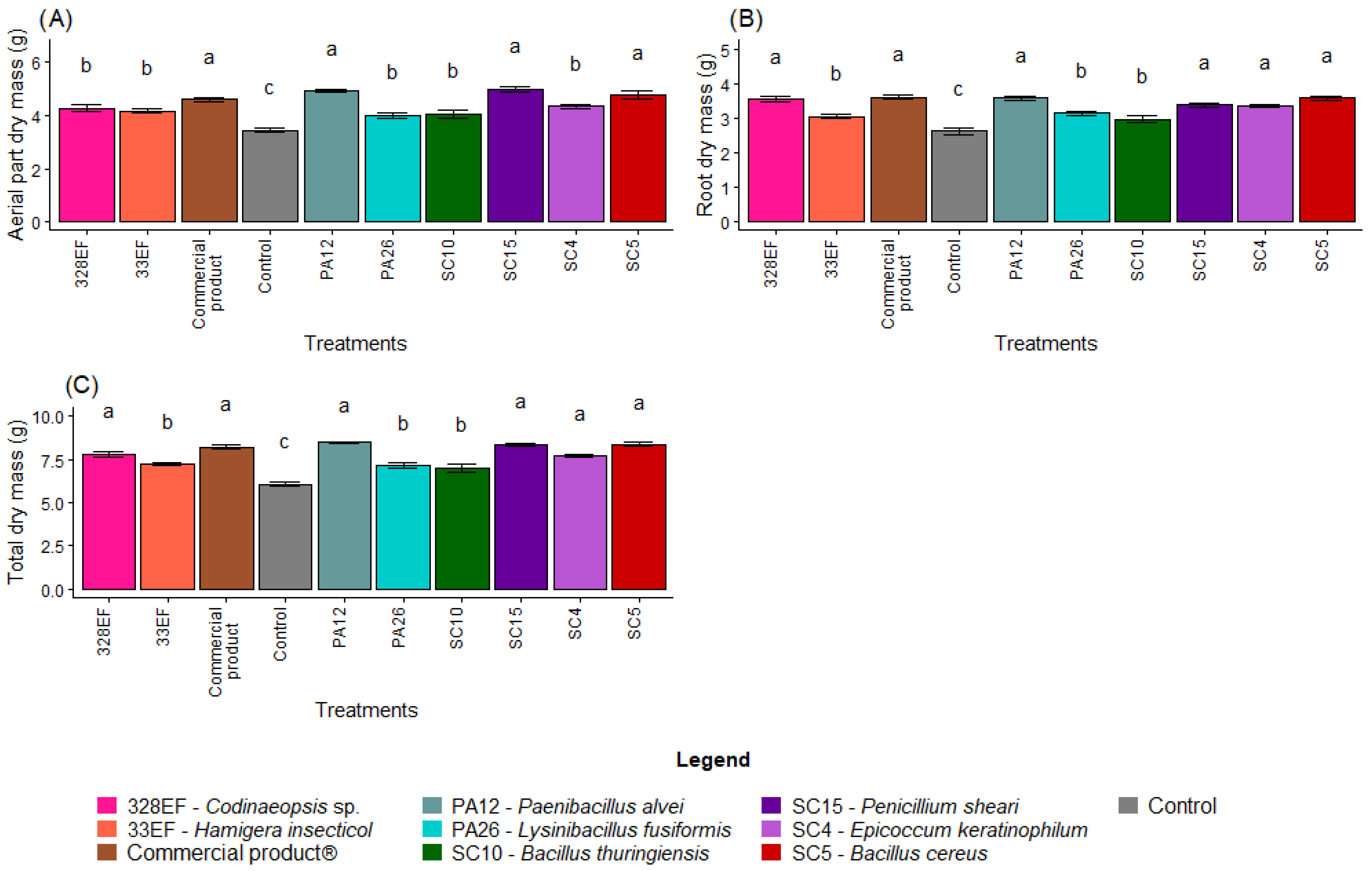

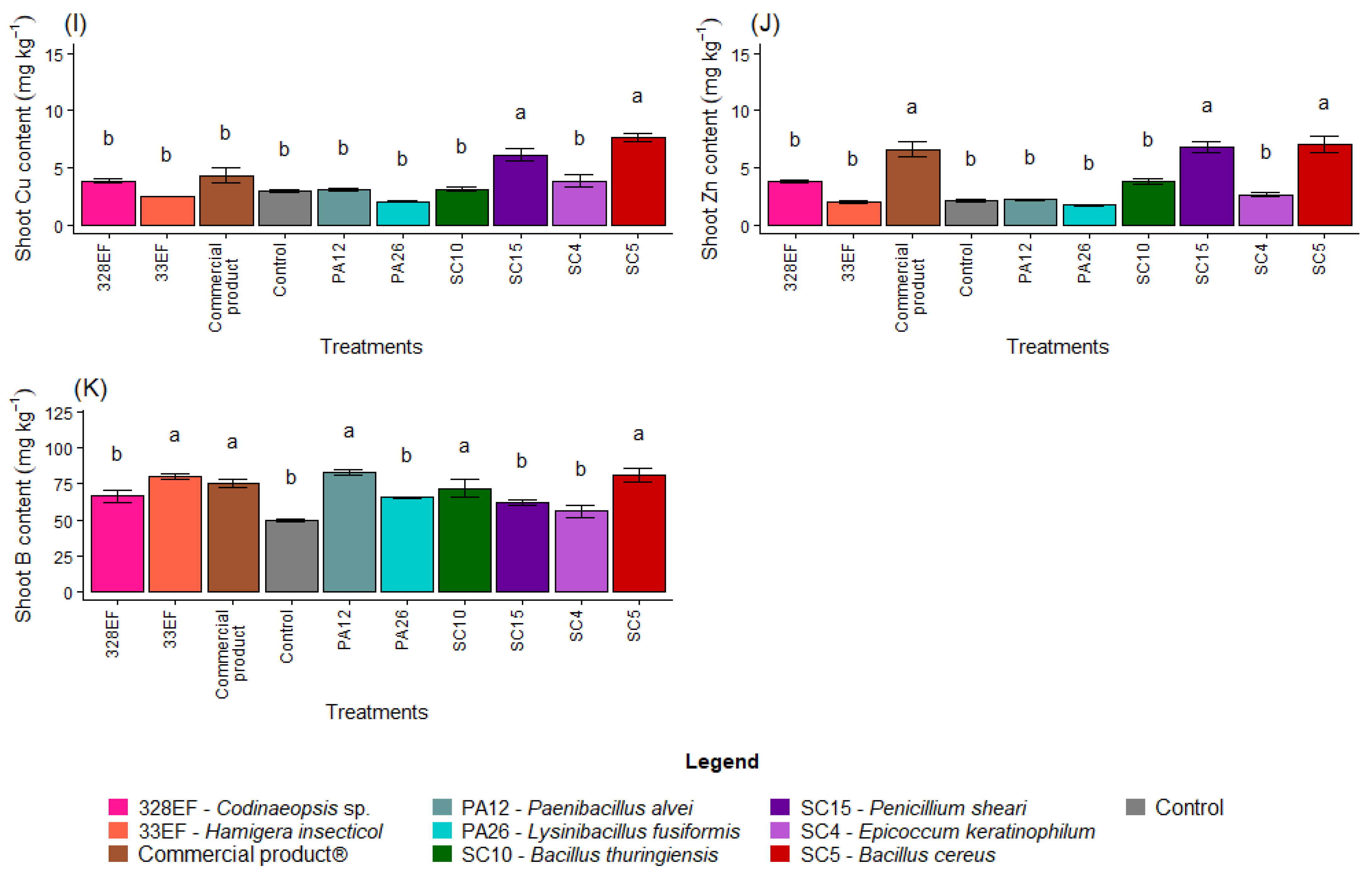
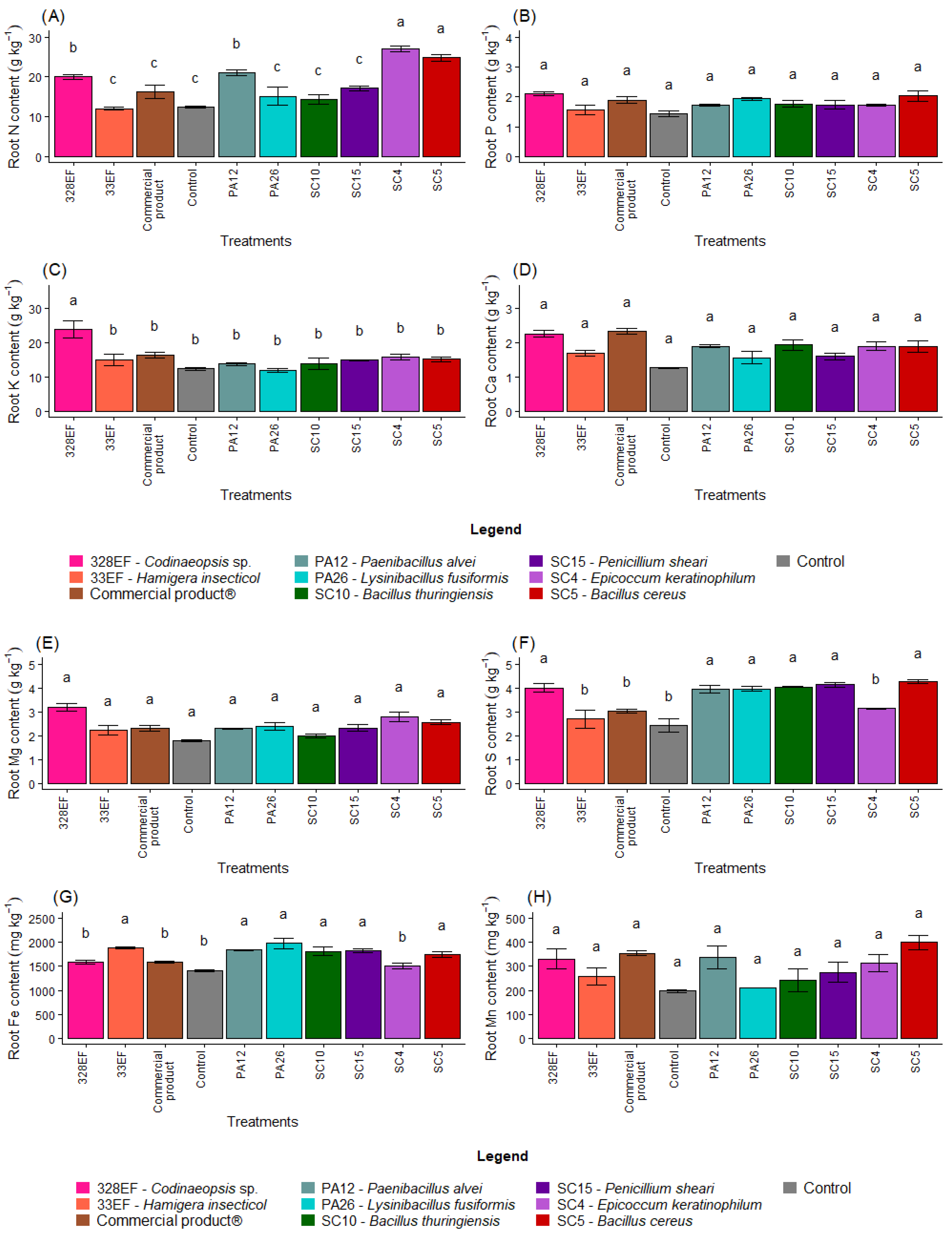
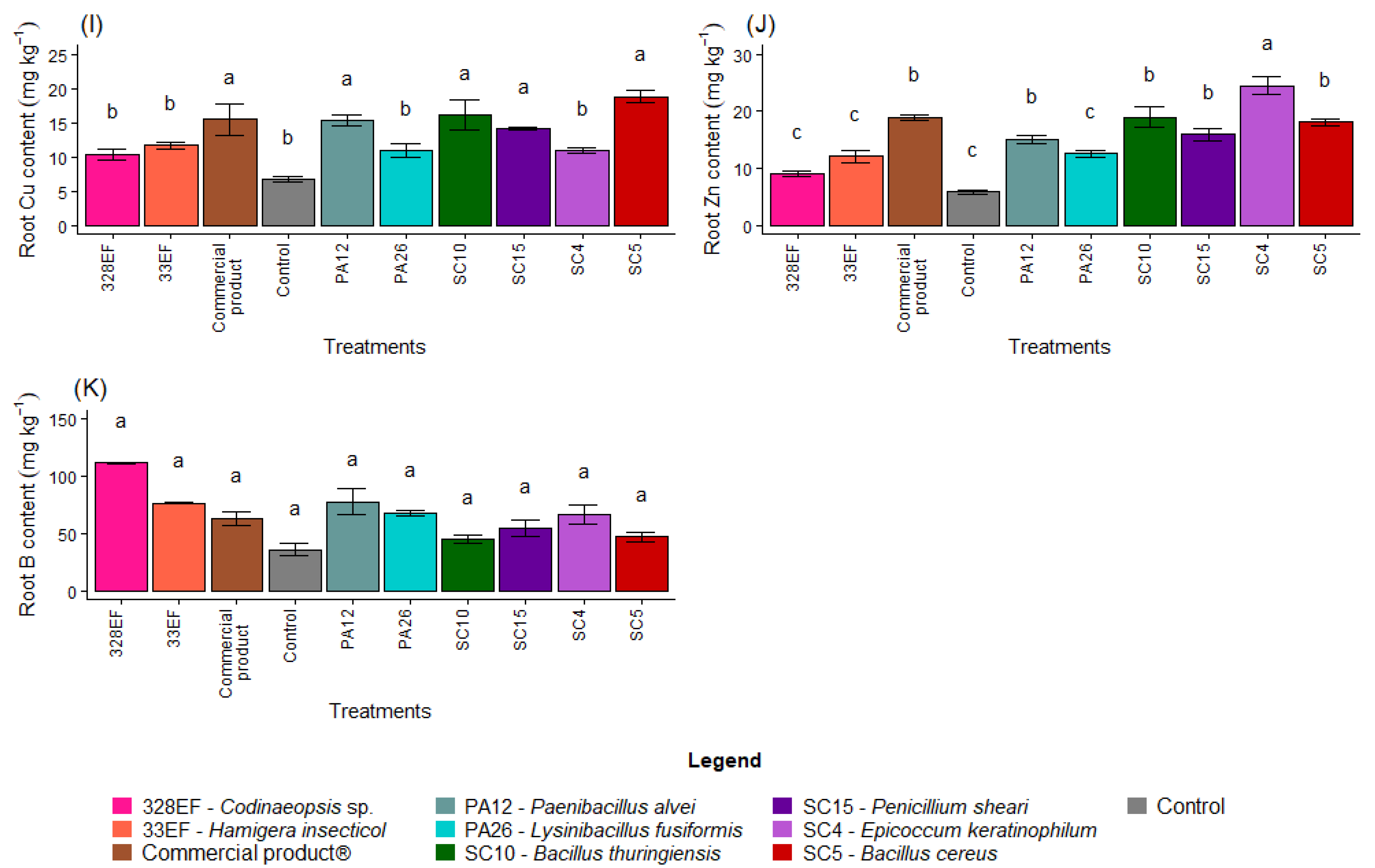
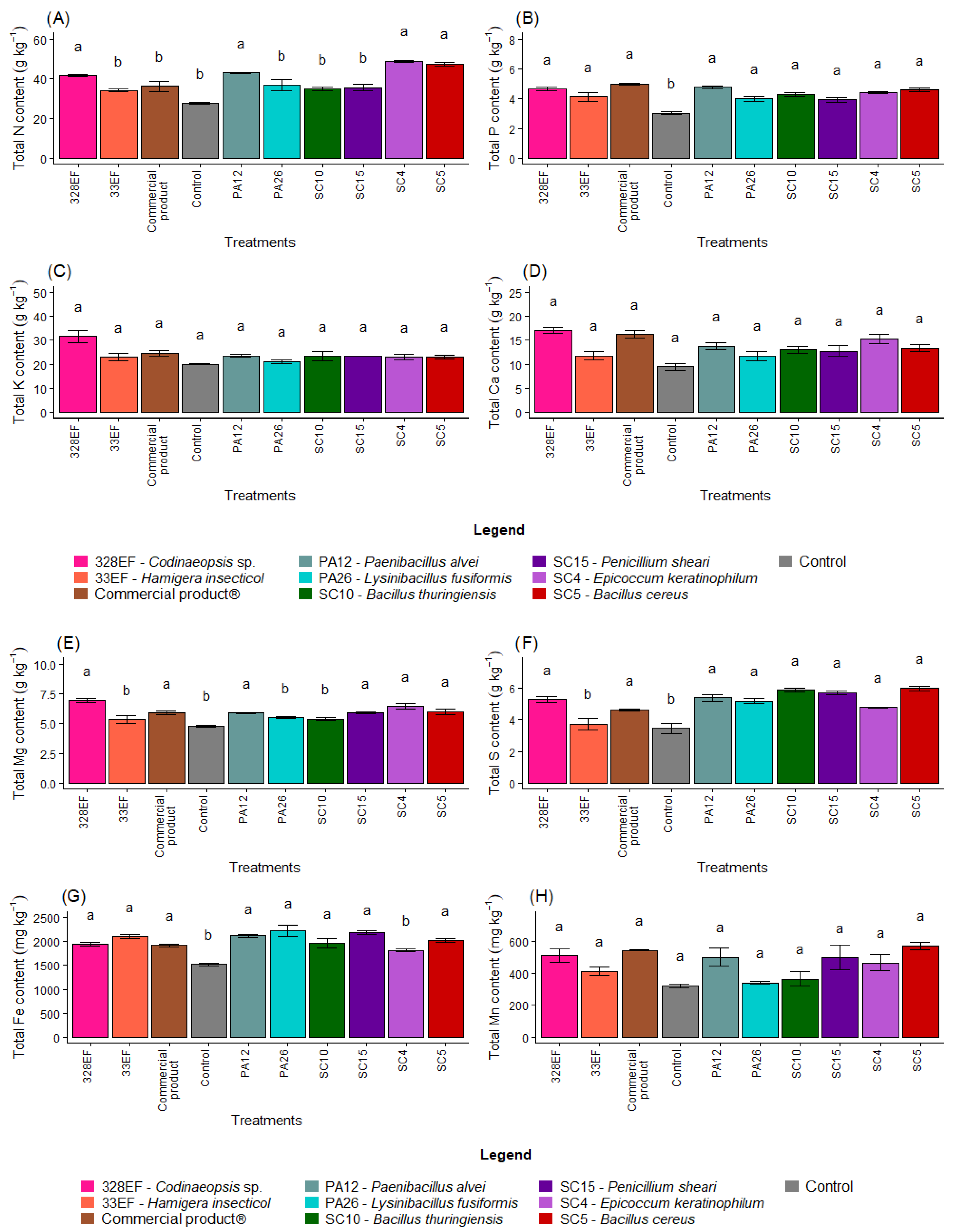


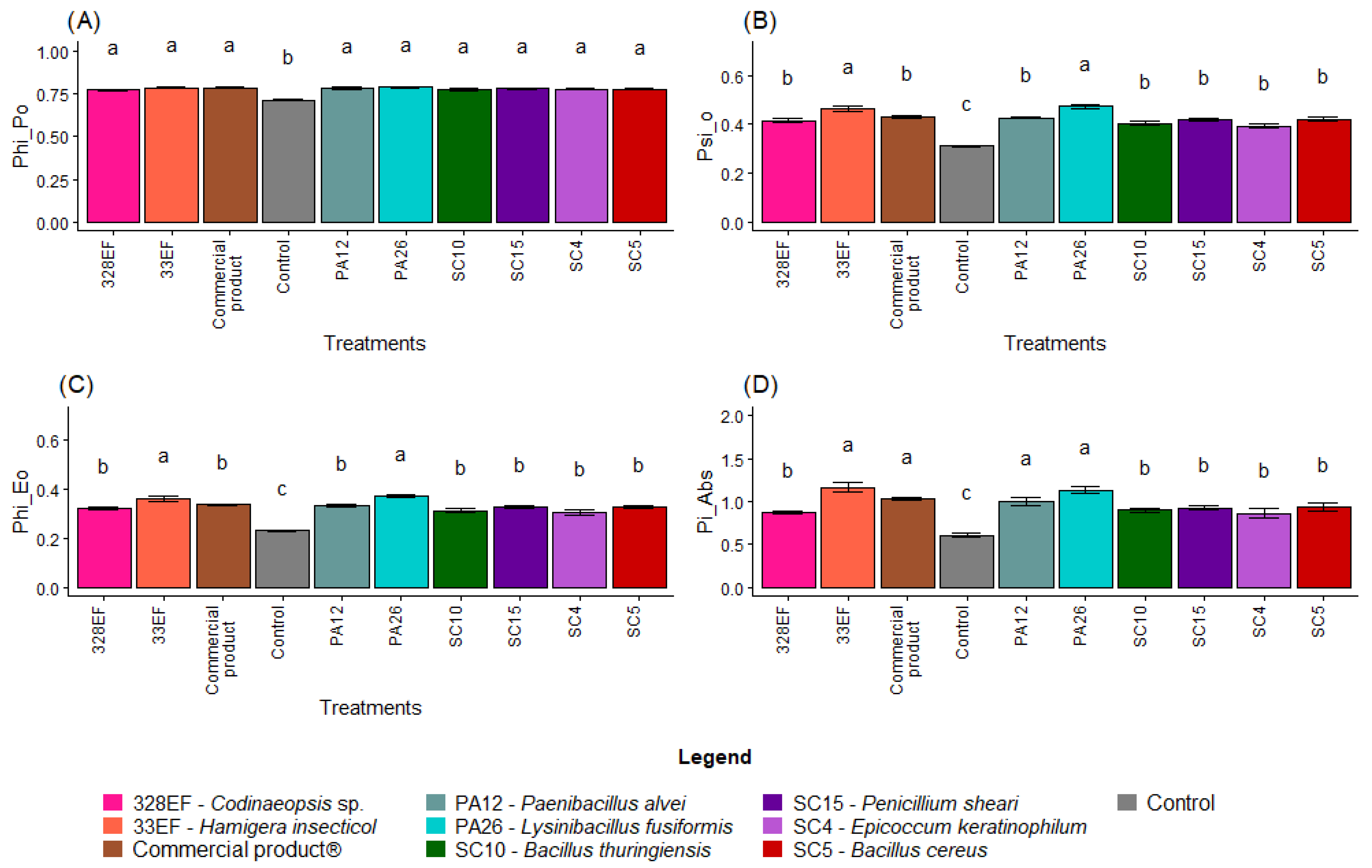
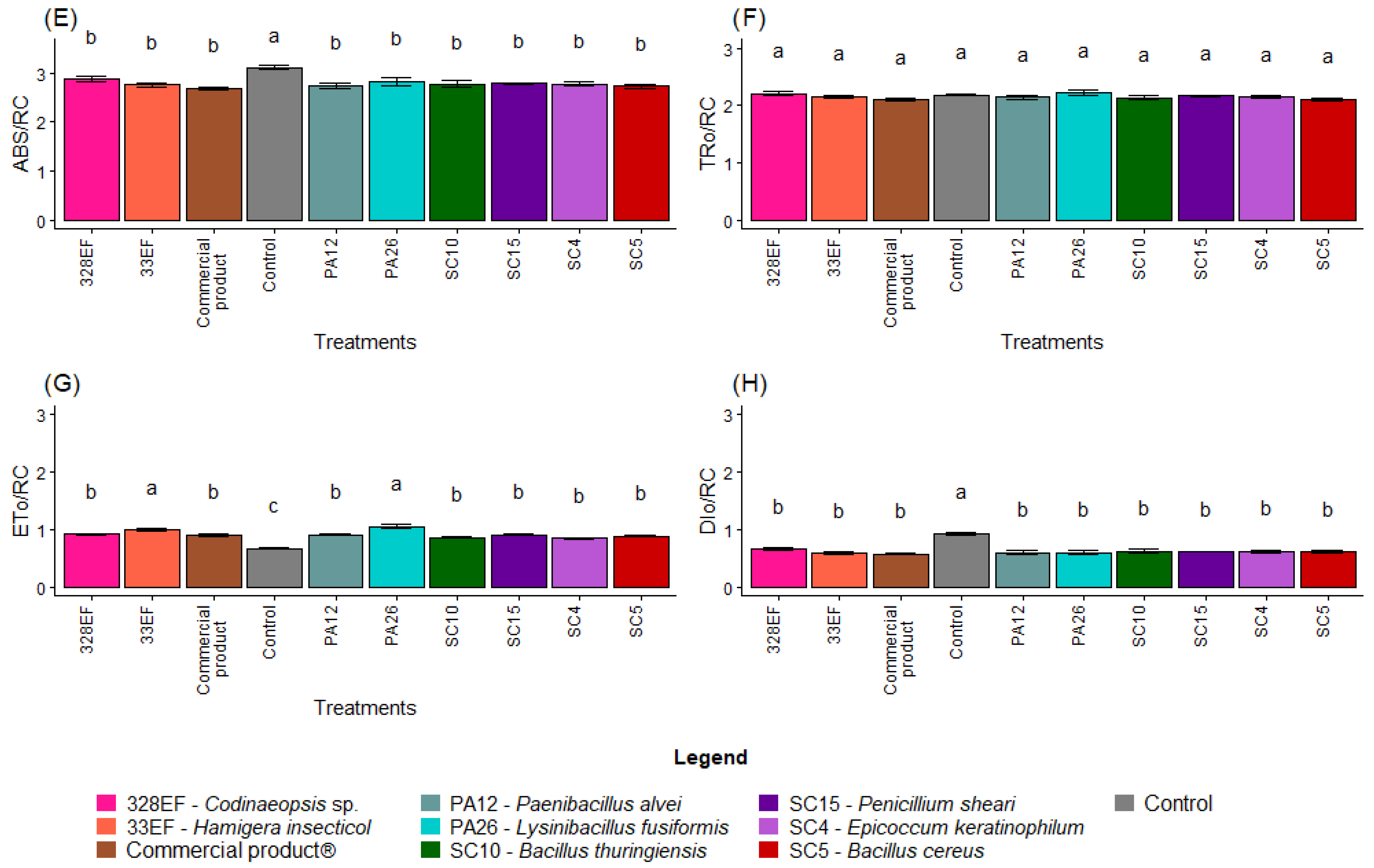

| Isolate | Type | Isolate Code | Origin |
|---|---|---|---|
| Penicillium sheari | Fungus | HSCR15 (SC15) | Hymenaea courbaril |
| Epicoccum keratinophilum | Fungus | HSCR4 (SC4) | Hymenaea courbaril |
| Hamigera insecticola | Fungus | BP33EF (33EF) | Butia purpurascens |
| Codinaeopsis sp. | Fungus | BP328EF (328EF) | Butia purpurascens |
| Bacillus cereus | Bacterium | HSCE5 (SC5) | Hymenaea courbaril |
| Bacillus thuringiensis | Bacterium | HSCR10 (SC10) | Hymenaea courbaril |
| Paenibacillus alvei | Bacterium | HPAR12 (PA12) | Hymenaea courbaril |
| Lysinibacillus fusiformis | Bacterium | HPAR26 (PA26) | Hymenaea courbaril |
| Bacillus megaterium and Bacillus subtilis | Bacteria | BRM034840 and BRM033112 | Commercial product |
| Ca | Mg | Ca + Mg | Al | H + Al | K | S | P (Mehlich) | P (Remaining) | CaCl2 |
|---|---|---|---|---|---|---|---|---|---|
| cmolc dm−3 (atomic weight in g/valence/100) | mg dm−3 | pH | |||||||
| 0.90 | 0.05 | 0.95 | 0.0 | 1.8 | 12.5 | 6.29 | 0.44 | 0.0 | 4.66 |
| Na | Fe | Mn | Cu | Zn | B | CTC a | SB b | V% c | m% d |
| Micronutrients (mg dm−3) | cmolc dm−3 | Sat. Bases | Sat. Al | ||||||
| 0.00 | 0.0 | 0.0 | 0.0 | 0.0 | 0.0 | 2.77 | 0.97 | 35.02 | 0.0 |
| Texture (g kg−1) | M.O. e | Ca/Mg | Ca/K | Mg/K | Ca/CTC | Mg/CTC | K/CTC | ||
| Clay | Silt | Sand | g dm−3 | Relationship between bases | |||||
| 247.5 | 62.5 | 190.0 | 8.2 | 21.0 | 28.0 | 1.4 | 32.3 | 1.56 | 1.15 |
Publisher’s Note: MDPI stays neutral with regard to jurisdictional claims in published maps and institutional affiliations. |
© 2022 by the authors. Licensee MDPI, Basel, Switzerland. This article is an open access article distributed under the terms and conditions of the Creative Commons Attribution (CC BY) license (https://creativecommons.org/licenses/by/4.0/).
Share and Cite
Reis, M.N.O.; Vitorino, L.C.; Lourenço, L.L.; Bessa, L.A. Microbial Inoculation Improves Growth, Nutritional and Physiological Aspects of Glycine max (L.) Merr. Microorganisms 2022, 10, 1386. https://doi.org/10.3390/microorganisms10071386
Reis MNO, Vitorino LC, Lourenço LL, Bessa LA. Microbial Inoculation Improves Growth, Nutritional and Physiological Aspects of Glycine max (L.) Merr. Microorganisms. 2022; 10(7):1386. https://doi.org/10.3390/microorganisms10071386
Chicago/Turabian StyleReis, Mateus Neri Oliveira, Luciana Cristina Vitorino, Lucas Loram Lourenço, and Layara Alexandre Bessa. 2022. "Microbial Inoculation Improves Growth, Nutritional and Physiological Aspects of Glycine max (L.) Merr." Microorganisms 10, no. 7: 1386. https://doi.org/10.3390/microorganisms10071386
APA StyleReis, M. N. O., Vitorino, L. C., Lourenço, L. L., & Bessa, L. A. (2022). Microbial Inoculation Improves Growth, Nutritional and Physiological Aspects of Glycine max (L.) Merr. Microorganisms, 10(7), 1386. https://doi.org/10.3390/microorganisms10071386






